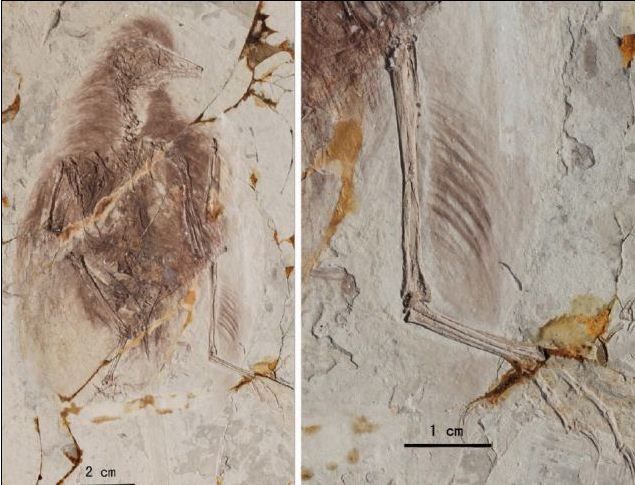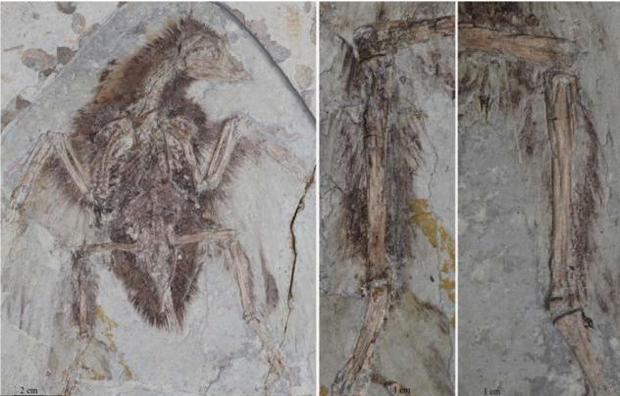oviraptor
(偷蛋龍)
超級版主
 






UID 2
精華
4
積分 1955
帖子 1241
閱讀權限 150
註冊 2006-10-16
來自 香港
狀態 離線
|
[廣告]:
Paleontologists find four-winged fossil birds in China

Paleontologists at the Chinese Academy of Sciences have discovered fossils of four-winged birds in Liaoning, northeastern China. The researchers say that contrary what is believed, the fossils suggest that the first birds used four wings for flight.
In a paper titled: "Hind Wings in Basal Birds and the Evolution of Leg Feathers" published in the journal Science, the Chinese researchers led by Xiatong Zheng of China's Linyi University and Xing Xu of the Institute of Geology and Paleontology in Shandong, China, studied well-preserved fossils of primitive birds donated to the Shandong Tianyu Museum of Nature by several fossil collectors. The specimens came from at least four diverse groups of "basal birds" including Sapeornis, Yanornis and Confuciusornis species, dating from about 100 million to 150 million years. They found evidence of feathers in the hind limbs of 11 "basal bird" specimens all from the Lower Cretaceous Jenol Group in China.
Modern birds have vaned feathers that cover the exterior of the body and down feathers growing underneath. The Chinese team found vaned flight feathers in the hind legs of the "basal bird" fossils, suggesting that the earliest birds had a four-winged plan and that birds gradually lost the feathers on their hind limbs in the course of evolutionary history.
They concluded from their study that contrary to what paleontologists have believed, the world's first birds all had four wings and flew like biplanes such as the Wright Brothers' Kitty Hawk plane.
According to Nature.com, one of the "basal bird" specimens of the Sapeornis genus, had at least one hind limb feather longer than 50 millimeters. Feathers on the feet were shorter, but longer than 30 millimeters.
Nature.com reports that Xu said: "It is amazing that so many early birds had large leg feathers." He said the findings "are important for both flight origin and feather evolution."
The researchers said the fossil evidence indicates that four-winged birds were more common millions of years ago, with the first set of wings acting like modern bird wings and the other set helping to steer and glide.
According to the researchers, the leg feathers "either provided lift, or created drag, or enhanced maneuverability or a combination of all of these functions."

Four-winged bird Sapeornis
The researchers suggested that the biplane "Kitty Hawk" model for flight is the simplest form of flight and that "The first birds descended from four-winged dinosaurs, which are not necessarily gliders in the strictest sense." (Discovery News).
Prior to the study, archaeologists had found and studied several dinosaur fossils with a four-wing structure, that is, large feathers on the fore and hind limbs. The feathered dinosaurs were first discovered in China in 2001, and included fossils of Microraptor and Sinonithosaurus (Nature.com). They are believed to have used their feathered rear legs for aerial locomotion, for gliding or parachuting between trees.

The New York Times notes that the status of the well known "four-winged" 150-million-year-old Archaeopteryx as the "first bird" has been disputed and many experts now consider it a "bird-like dinosaur" rather than a "dinosaur-like bird," and therefore do not consider it the first true example of a four-winged bird. Thus, before the new Chinese study, experts had considered that no examples of birds with four-winged body plan were known. This led scientists to the conclusion that the first birds that took to the skies in the Cretaceous about 100 million years ago had abandoned the four-wing body plan of their dinosaur ancestors.
According to Discovery News, Xu explained that ancient birds lived mostly on trees and would usually have taken off from a tree instead of from the ground or from water. Birds lost the second set of wings "primarily because of the evolution of two different locomotion systems in birds — arm wings for flight and legs for walking and running." He said that the shift, as evolution progressed, from tree habitat to ground habitat meant that birds developed legs for running and arms for flight leading to loss of the flight functions of the legs.
But some experts dispute the Chinese researchers' conclusion. Nature.com reports that Mark Norell, a paleontologist at the American Museum of Natural History in New York argued that the fossils do not show how the "basal birds" used their rear feathers. He also said the sampling was too small to establish the view that four wings were the rule for early birds." He said: "Flight is many things to many people. The origin of flight is not going to come from just one discovery."
Discovery News reports that although Kevin Padian, paleontologist at the University of California at Berkeley, agreed that the research establishes that leg feathers were widely distributed, he was not convinced that the leg feathers were actually used for flight.
He said: "No one thinks that these animals flapped their legs, so what is the argument about improving flight?... no one has performed any kind of adequate functional or aerodynamic test."
Read more: http://www.digitaljournal.com/article/345743#ixzz2NhEDAm00
| 
(\\\\\) (\\\\\) (\\\\\) (/////) (/////) (/////) |
|





